Post by trinitydobes on Aug 13, 2011 15:31:59 GMT -5
Puppy Test - PAWS Working Dog Evaluation
PAWS Working Dog Evaluation
Reprinted with permission by the creator / author Jona Decker malinut.com/ref/write/paws/
For years I used the Puppy Aptitude Test (P.A.T.), developed by Jack and Wendy Volhard, to evaluate puppies. As an obedience and agility competitor, it gave me insight into a puppy’s future personality. But as I branched out into other activities, I found myself adding to the test, evaluating things like “possessiveness” and “hunt drive.” Finally, it occurred to me to write it down, and really analyze the way I was making my decisions.
The result was the PAWS Working Dog Evaluation ©, which stands for Possessiveness, Attention, Willingness, and Strength.
Unlike the P.A.T., which was developed to evaluate good "pet" temperaments, The PAWS test was developed to help identify and evaluate the main components of good "working" temperaments—for dogs being selected for work in K9, Scent Detection, Search, French Ring, Schutzhund, Agility, Obedience, and similar activities. Why Possessiveness, Attention, Willingness, and Strength? In all of these activities, we use the dog’s possessiveness and drive to train, and eventually at work or on the field. But without attention and willingness to work for the handler, the most driven, possessive dog is virtually useless.
The test is divided into seven areas, and is more flexible in regard to age than the P.A.T. I still use the P.A.T. as an initial indicator, and pups that pass with acceptable levels move on to the PAWS. Instead of a numeric score, I use the evaluations of Excellent, Okay, and Indifferent. Depending on what activity the puppy is intended for, I place more weight on certain elements of the test.
The Test
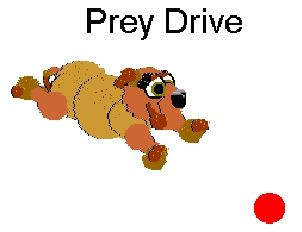
Test 1: Prey Drive
Using age appropriate teaser, tester gets dog’s attention and throws the teaser a short distance away. (Note: roll/bounce teaser with younger puppies.)
■EXC Puppy runs to teaser and immediately snatches up, perhaps shaking to "kill" it.
■OK Puppy runs to teaser and checks it out. May pick up toy if thrown repeatedly.
■IND Puppy doesn’t run to teaser or shows no interest.
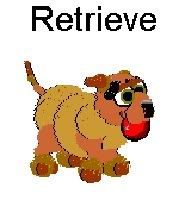
Test 2: Retrieve
After puppy gets teaser, tester encourages puppy to bring back by jogging backwards and calling.
■EXC Immediately brings back and spits out toy for more play.
■OK Brings back but doesn’t give up toy.
■OK Brings back but darts out of reach, wanting you to chase.
■IND Doesn’t bring back.
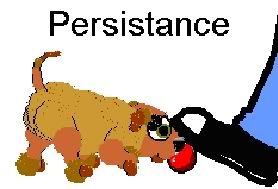
Test 3: Hunt Drive (Persistence)
Hide teaser under foot or in hands (just barely showing) and encourage puppy to find.
■EXC Digs, mouths, and whines for toy.
■OK Nudges and uses paws for toy.
■IND Tries halfheartedly or not at all.
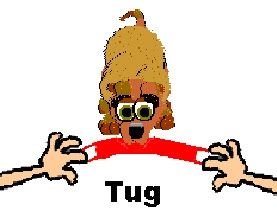
Test 4: Tug Response
Using towel, booda, or rag, tease puppy and allow to grab.
■EXC Immediately grabs and tugs vigorously.
■OK Grabs with repeated teasing and/or encouragement, lets go.
■IND Grabs only if repeatedly teased. Won’t hold on.

Test 5: Possessiveness
Tester lets go of tug while in puppy’s mouth.
■EXC Shakes toy to "kill" it, tries to engage tester to play again.
■EXC Shakes toy to "kill" it, runs away with toy.
■EXC Regrips and carries, tries to engage tester to play again.
■EXC Regrips and carries away toy.
■OK Runs away with toy, drops soon after.
■IND Drops immediately.
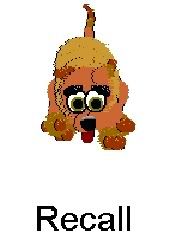
Test 6: Follow (<3 months)/Recall (>3 months)
Helper restrains while tester jogs backwards and calls dog’s name once. Clapping OK for young puppies.
■EXC Runs to tester, ramming shoulder into tester’s leg or jumping up.
■EXC Runs to tester and solicits affection.
■OK Jogs to tester, nudging or looking for attention.
■IND Jogs to tester & leaves, or doesn’t come at all.
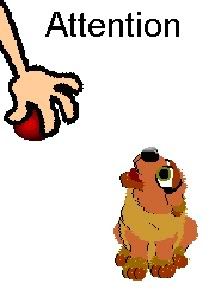
Test 7: Attention Span
Using age appropriate teaser, get dog’s attention and bring teaser to tester’s face level. Use teaser sparingly to maintain eye/facial contact with puppy for 30 seconds.
■EXC Willingly looks at tester’s face and toy for duration. Cocks head to listen.
■EXC Watches tester for duration, looking away briefly if background distractions interfere.
■OK Watches tester but needs to be re-engaged a few times.
■IND Easily distracted or unwilling to look at tester’s face.
An Application
A 20 month old Belgian Malinois was being evalated as a narcotics and search dog with potential for schutzhund. The dog was very social with people, good with other dogs, and not sound sensitive.
I chose a Water Kong toy (the kind on the rope) for the test. His prey drive was intense, and he retrieved to hand with little encouragement—actually tossing the kong to me to throw again. When the kong was hidden, he dug, mouthed, and whined for the toy. Since he was being evaluated for narcotics and search, I chose to go one step further and hide the kong in tall grass to further evaluate the hunt drive, both seen (thrown) and unseen. This dog worked quickly and thoroughly without encouragement, found the kong and pounced on it, then brought it to me. We played tug, and he was extremely possessive when tugging, but not aggressive. Upon my release of the kong, he shook it, then tossed it back to me for more games.
Because of the desired potential for schutzhund, the dog’s grip quality was also assessed on a sleeve. Despite the dog’s hecticness on a kong, he showed a very fast, strong strike with a lot of pushing in to stuff his mouth. There was some thrashing when the sleeve was slipped.
Since he was already a young adult, I had an assistant restrain the dog while I walked about 75 yards away. With one call of his name, the dog ran at top speed and nailed me right in the stomach with both front legs.
As the last test, I got his attention and proceeded to talk quietly to him for thirty seconds. The dog didn’t take his eyes off of me, and cocked his head from side to side as I spoke, maintaining eye contact as I moved.
As far as I was concerned, this dog was a perfect match for his desired occupation. He showed very good hunt drive and persistance, the makings of a good scent dog (of whatever flavor—tracking, search, scent detection). In addition, he showed strong prey, possessiveness, recall, and attention—all necessary attributes for a good schutzhund dog. All in all, he tested at a high level on all the tests. With the right handler, this dog could succeed in almost any arena. On the other hand, this was a very INTENSE, physical, high drive dog. Sitting in someone’s living room, he could probably be a downright pain.
Would this dog be a High in Trial obedience dog or national agility contender? Maybe. He would take a high-end handler with experience channeling that drive into precision. Everyone who has had a low-key dog wants "drive" in their next one—and then they get it. His vigor and physicality could cause him to lose points or bust (touching on recall, blowing contact zones, for example) with all but the most perfect training. Is this a consideration, in this example? Not at all. For his purposes, this dog suited the handler perfectly.
For more information on the PAWS Working Dog Evaluation, please e-mail me at jona@redtaildesign.com. Please do not e-mail me with "my dog aced your test now whatdoido?" questions.
The illustrations of each test were produced from screenshots of PF.MAGIC’s DOGZ Program©.
PAWS Working Dog Evaluation
Reprinted with permission by the creator / author Jona Decker malinut.com/ref/write/paws/
For years I used the Puppy Aptitude Test (P.A.T.), developed by Jack and Wendy Volhard, to evaluate puppies. As an obedience and agility competitor, it gave me insight into a puppy’s future personality. But as I branched out into other activities, I found myself adding to the test, evaluating things like “possessiveness” and “hunt drive.” Finally, it occurred to me to write it down, and really analyze the way I was making my decisions.
The result was the PAWS Working Dog Evaluation ©, which stands for Possessiveness, Attention, Willingness, and Strength.
Unlike the P.A.T., which was developed to evaluate good "pet" temperaments, The PAWS test was developed to help identify and evaluate the main components of good "working" temperaments—for dogs being selected for work in K9, Scent Detection, Search, French Ring, Schutzhund, Agility, Obedience, and similar activities. Why Possessiveness, Attention, Willingness, and Strength? In all of these activities, we use the dog’s possessiveness and drive to train, and eventually at work or on the field. But without attention and willingness to work for the handler, the most driven, possessive dog is virtually useless.
The test is divided into seven areas, and is more flexible in regard to age than the P.A.T. I still use the P.A.T. as an initial indicator, and pups that pass with acceptable levels move on to the PAWS. Instead of a numeric score, I use the evaluations of Excellent, Okay, and Indifferent. Depending on what activity the puppy is intended for, I place more weight on certain elements of the test.
The Test

Test 1: Prey Drive
Using age appropriate teaser, tester gets dog’s attention and throws the teaser a short distance away. (Note: roll/bounce teaser with younger puppies.)
■EXC Puppy runs to teaser and immediately snatches up, perhaps shaking to "kill" it.
■OK Puppy runs to teaser and checks it out. May pick up toy if thrown repeatedly.
■IND Puppy doesn’t run to teaser or shows no interest.

Test 2: Retrieve
After puppy gets teaser, tester encourages puppy to bring back by jogging backwards and calling.
■EXC Immediately brings back and spits out toy for more play.
■OK Brings back but doesn’t give up toy.
■OK Brings back but darts out of reach, wanting you to chase.
■IND Doesn’t bring back.

Test 3: Hunt Drive (Persistence)
Hide teaser under foot or in hands (just barely showing) and encourage puppy to find.
■EXC Digs, mouths, and whines for toy.
■OK Nudges and uses paws for toy.
■IND Tries halfheartedly or not at all.

Test 4: Tug Response
Using towel, booda, or rag, tease puppy and allow to grab.
■EXC Immediately grabs and tugs vigorously.
■OK Grabs with repeated teasing and/or encouragement, lets go.
■IND Grabs only if repeatedly teased. Won’t hold on.

Test 5: Possessiveness
Tester lets go of tug while in puppy’s mouth.
■EXC Shakes toy to "kill" it, tries to engage tester to play again.
■EXC Shakes toy to "kill" it, runs away with toy.
■EXC Regrips and carries, tries to engage tester to play again.
■EXC Regrips and carries away toy.
■OK Runs away with toy, drops soon after.
■IND Drops immediately.

Test 6: Follow (<3 months)/Recall (>3 months)
Helper restrains while tester jogs backwards and calls dog’s name once. Clapping OK for young puppies.
■EXC Runs to tester, ramming shoulder into tester’s leg or jumping up.
■EXC Runs to tester and solicits affection.
■OK Jogs to tester, nudging or looking for attention.
■IND Jogs to tester & leaves, or doesn’t come at all.

Test 7: Attention Span
Using age appropriate teaser, get dog’s attention and bring teaser to tester’s face level. Use teaser sparingly to maintain eye/facial contact with puppy for 30 seconds.
■EXC Willingly looks at tester’s face and toy for duration. Cocks head to listen.
■EXC Watches tester for duration, looking away briefly if background distractions interfere.
■OK Watches tester but needs to be re-engaged a few times.
■IND Easily distracted or unwilling to look at tester’s face.
An Application
A 20 month old Belgian Malinois was being evalated as a narcotics and search dog with potential for schutzhund. The dog was very social with people, good with other dogs, and not sound sensitive.
I chose a Water Kong toy (the kind on the rope) for the test. His prey drive was intense, and he retrieved to hand with little encouragement—actually tossing the kong to me to throw again. When the kong was hidden, he dug, mouthed, and whined for the toy. Since he was being evaluated for narcotics and search, I chose to go one step further and hide the kong in tall grass to further evaluate the hunt drive, both seen (thrown) and unseen. This dog worked quickly and thoroughly without encouragement, found the kong and pounced on it, then brought it to me. We played tug, and he was extremely possessive when tugging, but not aggressive. Upon my release of the kong, he shook it, then tossed it back to me for more games.
Because of the desired potential for schutzhund, the dog’s grip quality was also assessed on a sleeve. Despite the dog’s hecticness on a kong, he showed a very fast, strong strike with a lot of pushing in to stuff his mouth. There was some thrashing when the sleeve was slipped.
Since he was already a young adult, I had an assistant restrain the dog while I walked about 75 yards away. With one call of his name, the dog ran at top speed and nailed me right in the stomach with both front legs.
As the last test, I got his attention and proceeded to talk quietly to him for thirty seconds. The dog didn’t take his eyes off of me, and cocked his head from side to side as I spoke, maintaining eye contact as I moved.
As far as I was concerned, this dog was a perfect match for his desired occupation. He showed very good hunt drive and persistance, the makings of a good scent dog (of whatever flavor—tracking, search, scent detection). In addition, he showed strong prey, possessiveness, recall, and attention—all necessary attributes for a good schutzhund dog. All in all, he tested at a high level on all the tests. With the right handler, this dog could succeed in almost any arena. On the other hand, this was a very INTENSE, physical, high drive dog. Sitting in someone’s living room, he could probably be a downright pain.
Would this dog be a High in Trial obedience dog or national agility contender? Maybe. He would take a high-end handler with experience channeling that drive into precision. Everyone who has had a low-key dog wants "drive" in their next one—and then they get it. His vigor and physicality could cause him to lose points or bust (touching on recall, blowing contact zones, for example) with all but the most perfect training. Is this a consideration, in this example? Not at all. For his purposes, this dog suited the handler perfectly.
For more information on the PAWS Working Dog Evaluation, please e-mail me at jona@redtaildesign.com. Please do not e-mail me with "my dog aced your test now whatdoido?" questions.
The illustrations of each test were produced from screenshots of PF.MAGIC’s DOGZ Program©.